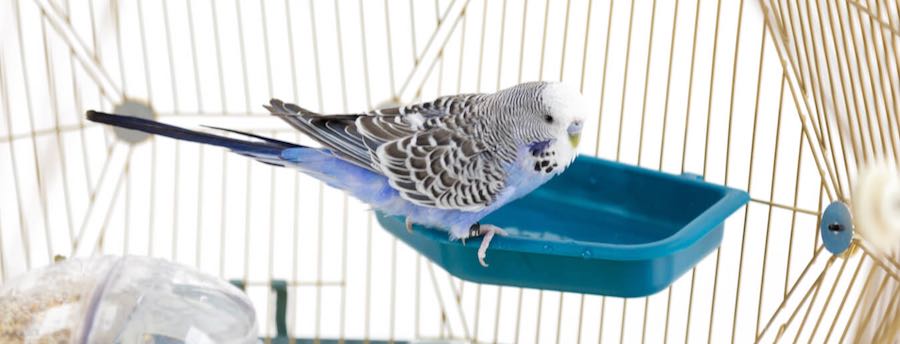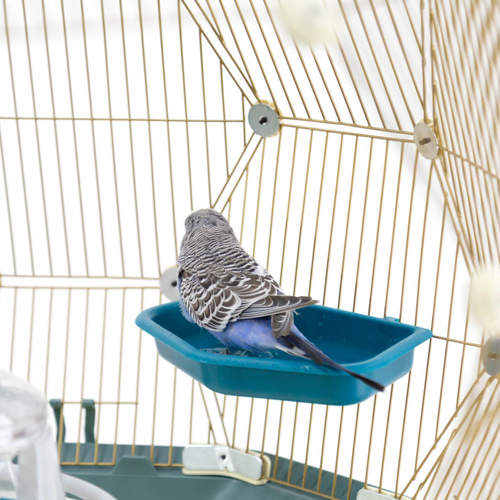Why Birds Love to Bathe

It’s a dusty business being a pet bird, in a world of sawdust, seed husks and the dry atmosphere of the great indoors. The dust gets lodged at the base of the feathers, and the skin starts to get itchy. This is why most birds absolutely love taking a wet bath.
This doesn’t apply to all species, though. Every chicken keeper knows how much their hens love a good dust bath – making things drier and dustier than ever. You may also notice wild birds such as blackbirds and sparrows dustbathing too.
Many birds happily mix and match these two different bathing techniques. But in general, it is thought that the preference for one method over the other depends on where the birds originate. Land-based birds with access to water tend to bathe in it, while those in more arid habitats favor dustbathing. The dust helps maintain the correct oil balance on the bird’s feathers, and also deters parasites such as lice.
When a bird mixes and matches, it is both cleaning itself (with the water) and then de-lousing (with the dust).
 Bird Baths
Bird Baths
During hot weather, budgies may take a dip several times a day, given the chance. Their bath can be fixed inside the cage or can simply be a shallow bowl on the ground outside the cage. Keeping the bath external to the cage helps keep things dry and tidy. There’s a lot of flapping and splashing involved in bathing if you’re all hot and bothered and covered in feathers!
The bath serves at least three purposes. It helps the birds get clean; it helps them cool off; and it provides a lot of fun. Some birds can’t get enough of it; and yet some owners report that their bird baths are never used. This lack of appeal is a bit of a mystery. Given the chance, most budgies relish the chance to splash around, and will use their drinking water as a mini bath, if possible. Some, however, never get the bath bug. This is probably due to early exposure – if a bird hasn’t been given the opportunity to enjoy a soak during its first nine months, it may never acquire the taste.
An unbathed bird isn’t a problem – the budgie will still preen and ruffle its feathers to clean itself of dust, and it certainly won’t become smelly.
Budgies – most of them – also enjoy what is known as a ‘bird shower’: bunches of edible greens and herbs freshly dipped in water. These act like a budgie carwash, and the bird will enjoy rubbing and rolling in the moisture before shaking itself dry – and probably taking a bite or two from the shower to round things off!
Finch Baths
Everything that applies to budgie baths applies to finch baths too. Always make sure the ‘bathtub’ is secure – either fixed to the cage, or broad-bottomed so that it cannot be tipped over. Finches tend to be a bit nervous, and a wobbly bath will shake their confidence.
Some species, notably the canary, also love a spray-shower. Tepid-to-lukewarm water in a mister-spray is their version of a luxury spa session. Once your bird is hand-tamed, introduce the spray and see how the finch reacts. If it becomes scared, don’t continue, but try again later. In 90% of cases, your pet will come to love this form of pampering.
Parrot Baths
Like budgies, most larger parrots enjoy the opportunity to bathe. The water is thought to fulfil several different purposes, from cleaning the feathers and softening up dried-on dirt for easier removal, to assisting molting and helping the respiratory system.
Many parrots enjoy the spray-mist shower too, and some of the large species even acquire the taste for joining their owners in the shower room! This is not without its hazards, though. Parrots’ respiratory systems are sensitive to chemicals found in tap water, such as chlorine and fluorine. If your parrot is to be your shower companion, you will need to fit a shower filter that removes these chemicals
A wide dish is a more conventional bath for a parrot, though. The birds will use the dish for drinking as well as bathing, but that’s fine.
General Bird Bath Rules
Whatever type of birds you keep, their bath will become dirty very quickly, and the water will need replacing at least once a day. Many owners impose bath time on their birds, only introducing the water at certain times. In smaller cage set ups this is the best method, as it avoids everything getting very wet very quickly, and staying that way.
In a larger aviary, the bath is usually installed as a permanent cage feature. It’s always interesting to see which of the birds become ‘bath addicts’, and which ones prefer a quick preen-and-shake, no water required!
Whatever your set up, always make sure the water is at room (or ambient air) temperature. Allow cold tap water to cool first – a bird that takes a cold dip may suffer shock to the system and become ill.
Above all, bath time is fun – both for the bird, and as a spectator sport!
This entry was posted in Birds
One reply on “Why Birds Love to Bathe”
Does the enjoyment of splashing around in a bird bath suggest that birds have a natural instinct for cleanliness and hygiene, or is it simply a form of entertainment for them?